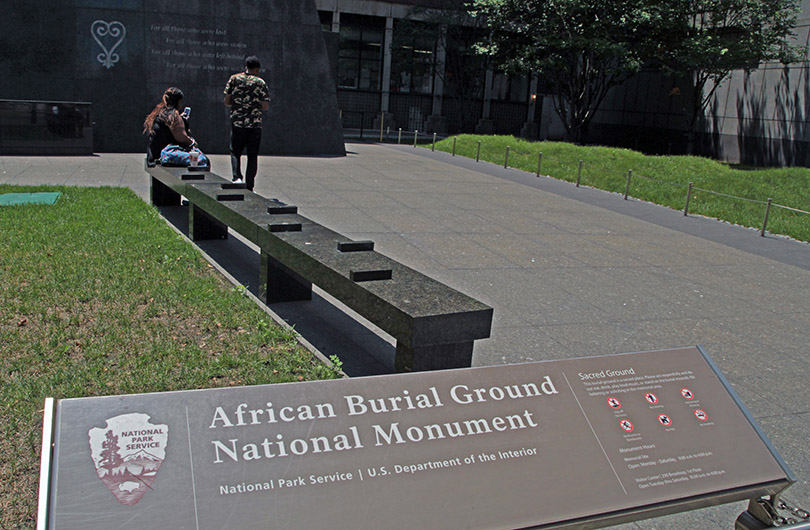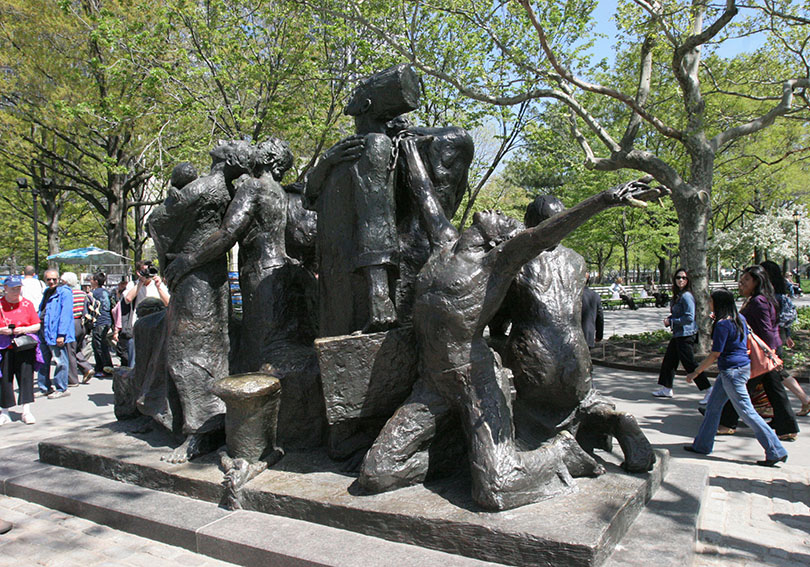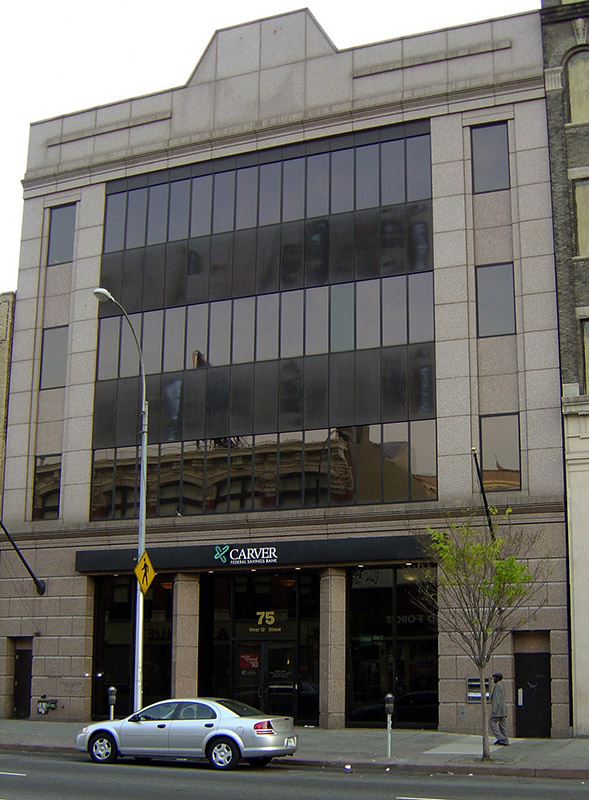
African Burial Ground in Lower Manhattan; (c) Soul Of America
New York City History
For early Native Americans, New York City was a relatively peaceful place to live, fish and farm many centuries before “discovery” by Europeans. For their largely nomadic lifestyles, the area we call Manhattan was just one of many places they frequented with the region.
Historian T. Rasul Murray notes that the first Africans to arrive in this area were not enslaved. Esteban De Gomez, an Afro-Portuguese explorer was the first known African to arrive in New York waters. Within a year of Veranzano’s exploration in 1524, De Gomez sailed through those same waters and up what we now call the Hudson River.
Murray further notes, that Jan Rodriguez, an Afro Caribbean explorer who traveled to Manhattan with the Dutch Captain Mozel in 1613, stayed after the Dutch left, becoming the first non-Native American resident of Manhattan island. Rodriguez is believed to have been one of five free persons of color to receive land grants by the Dutch in 1644, in what was called the Bowery Settlement.
In 1623, the Dutch settlers arrived. In 1626, the first enslaved Africans arrived in New York City. A few blacks earned their freedom in 1630, setting up a community in what is now called Greenwich Village (map). Murray points out that enslaved Africans built the new colony’s infrastructure; quarrying rock for the buildings, constructing buildings and roads
In 1658, the Dutch took control of the land and established Nieuw Haarlem in honor of Haarlem, Netherlands. By then Murray states, Africans widened the Bowery, an Indian trail that had reached from New Amsterdam to Governor Stuyvesant’sfarm, or Bowery, further north into the newly formed village of Niew Haarlem. In 1664, the English took control of the land and renamed it “New York.” Slavery remained a fact of life in the area, and it was present on what would now be called Wall Street (map).
When the Dutch lost control of Nieuw Haarlem to the British, residents dropped one “a” from the last name. During the colonial period, Harlem was the suburban home of prominent New York City families. The Morris-Jumel Mansion at 160th Street and Edgecombe Avenue (map), the oldest single family house still standing in Manhattan and Hamilton Grange at 141st Street and Convent Avenue (map), Alexander Hamilton’s summer home, were both built at that time.
Greenwich Village had Minetta Street near Sixth Ave, another African-American enclave. Murray clarifies other little-known facts about the area we call Lower Manhattan today. Hughson’s Tavern at Liberty and Trinity Streets near the waterfront was a meeting place for free and enslaved blacks, as well as poor whites. In those days, it was illegal for more than three slaves to meet unless they were working. In 1741, a white woman at Hughson’s Tavern accused black men of plotting to burn down the city. Those inflammatory remarks led to riots that left 30 blacks dead and 70 more deported from the colony.
In the 1770’s, General George Washington fought the British in the Battle of Harlem Heights (map). The Morris-Jumel Mansion was Washington’s temporary headquarters. Note that Africans fought on both sides of the war. Given some were escaped slaves, the lure of freedom as a soldier was a powerful attraction in this region and the rest of a newly forming nation.
By 1800, Philadelphia had 70,000 residents while New York City, the second largest city, had 60,000. Boston and Baltimore were close behind in population. Philadelphia and New York City both had stock markets and important seaports. So what set New York City on a trajectory that elevated its commerce well above Philadelphia, Boston and Baltimore? New York City had the Hudson River, which permitted ships to move to inland New York state closer to Midwest trade routes.
Commercial and government interests invested monies to extend a canal waterway to Lake Erie in 1825. When the canal opened, NYC enjoyed dramatically lower shipping costs for Midwest goods than any other Eastern seaport. New York City also received more immigrants than Philadelphia or Baltimore, due to it being closer to Europe by ship. A larger population of cheap immigrant labor depressed wages and lower cost of goods from the Midwest meant NYC retailers enjoyed a profits boom. New York City merchants also made more profit by distributing goods abroad.
In the late 1800s, Black churches such as Abyssinian Baptist and Mother AME Zion were established in the city. A short-lived enclave of ex-slaves and Irish immigrants called Seneca Village existed in what is now Central Park. This community, surrounded by 82nd, 89th Streets plus Seventh and Eighth Avenues (map), was established after New York state abolished slavery in 1827.
In the same year, Samuel Cornish and John Russwurm founded Freedom’s Journal in New York City, the first black newspaper in the nation. Though it only lasted a few years, the newspaper’s powerful objective was to assist the immediate freedom of slaves and social equality for all African Americans. Churches and schools to educate African-American children opened in what is today called the Theater District near Times Square.
In 1857, their land, bordered by 82nd, 89th Streets plus Seventh and Eighth Avenues, was purchased by the city at below market rates. The purchase enabled Frederick Law Olmstead to landscape the scale of the Central Park we see today. Many other Black properties were demolished or vandalized between 1855-1863 when anti-African American sentiment ran high.
Remaining Black Codes restricting the rights of free persons of color conditioned European Americans to think of African Americans as third-class citizens. The direct beneficiaries of this social conditioning of the White Male Ruling Elite were new European immigrants. Played like pawns in the social hierarchy, these immigrants gladly received second-class citizenship advantages getting and keeping jobs over Black predecessors in non-war time, even when many of those predecessors were more talented. Furthermore, Lincoln was a Republican.
Angry about his close presidential election win in 1860, the Democratic Party race-baited by warning New York’s European American residents to prepare for resultant labor competition from African Americans fleeing slavery.
The White Male Ruling Elite feared that the military advantages of allowing African Americans to arm and fight in the Civil War were outweighed by the potentially greater damage to the trickle down social order (Rich Whites > Poor Whites > Blacks) after the war. They understood that returning African-American veterans would have an elevated sense of dignity and be more empowered to raise their social status.
To prevent such a dramatic social change, a decision was made in the private power corridors of New York, Boston, Philadelphia, Baltimore and Washington. African Americans were not to be drafted for military service on the basis that they were not full citizens. Even volunteer military service by African Americans was severely limited or quarantined away from white soldiers without guns.
With the social order cemented and Democratic Party race-baiting as a backstory, the Emancipation Proclamation and a stricter federal draft law in 1863 reinforced the worst fears by Poor While Males in Northern cities. The Civil War was not going well for the North, so all white males ages 20-35 and all unmarried men between ages 35-45 were eligible to be drafted. The federal government entered them into a publicly held draft lottery. Rich white males could hire a substitute or pay the government $300 to avoid the lottery.
The sound-bite white public sentiment became that Poor Whites were fighting for Black Freedom. Newly drafted European Americans and poor European immigrants became angry at “stay behind” African Americans taking jobs, while poor whites sacrificed their lives in a war to end slavery.
The Democratic Party further inflamed tensions by publishing posters that hoards of southern Black people were on their way to New York. The White Male Ruling Elite were to blame, but they could hide behind police protection in their uptown mansions.
The first draft lottery was held on 11 July 1863. By 13 July, the Draft Riot was predictable. At first the white mob rioted against government buildings and the military. By mid-day, they vented anger on black businesses and workers because they symbolized economic and political progress at poor white male expense. The Draft Riot began at Chambers Street and Broadway (map) in Lower Manhattan then stormed northward.
To their enduring credit, white males in the multi-racial Five Points District successfully prevented angry White rioters from attacking Black residents. Five Points was a hard-knuckle slum centered on the intersection of Anthony (now Worth), Orange (now Baxter), Mulberry, Cross (now Mosco Street) and Little Water (which no longer exists) and the eastern corner of a public park then called “Paradise Square” (map). The name “Five Points” was derived from the five corner intersection, which no longer exists.

Immigrant Monument in Battery Park reminds us that all races moved here; (c) Soul Of America
The mob moved northward to Colored Orphan Asylum on Fifth Avenue between 43rd and 44th Streets (map). Well stocked with food, clothing and supplies, the asylum represented charity by the White Ruling Elite towards people of color, so the white mob burned it down. Though they let the children escape, anybody who showed sympathy towards the Black children was threatened or beaten.
Some in the mob even cheered the Confederate leader, Jefferson Davis. Having missed the opportunity to nip it in the bud earlier, the police failed to get matters under control until the riot and fires spread well beyond Poor White and Black districts and government buildings. The angry mob killed 11 blacks and maimed hundreds of others, particularly Black men. Considering the extent of documented damage, those numbers seem low.
The New York Historical Society has a library of information about this dramatic event. The riot reshaped New York City in several important ways and has national consequences that we feel today. Huge numbers of African Americans migrated from Midtown Manhattan to Brooklyn, which at the time was a separate city. With many buildings burned to the ground or damaged, theatre owners and office builders claimed most of the land at bargain prices to build the Broadway Theatre District and Midtown offices.
In 1873, Harlem (map) was annexed to New York City as its first suburb. In 1880, subways emerged as elevated rapid transit lines extended to Harlem, making it more accessible to the rest of the city.
During the 1890’s, many of Harlem’s brownstone homes were built to attract more upper income tenants. Prior to 1898, most African Americans who remained in New York City lived between 20th Street and 53rd Street. In 1898, New York consolidated five contiguous cities into one great city of five boroughs: Manhattan, The Bronx, Queens, Brooklyn and Staten Island. By 1900, New York City was the leading port of commerce in America, by far.
In 1906, real estate speculation began leading the wealthiest African Americans to Harlem and altering New York City History.
By 1914, water-borne export-import business and passenger traffic dominated commerce and public conversation. Hence, New York City felt a huge emotional loss when the Titanic headed its way, hit and iceberg and sank. In fact, a Titanic memorial was later built inear South Street Seaport (map).
In the same year, Germany bullied France and the rest of Europe. Shortly afterwards in 1914, Germany sank the Lusitania, an American ship, thereby pulling America into World War I and initiating another American draft. Once again, the White Male Elites, guided by racism, permitted very few African Americans to be trained to serve in combat for fear that many would return as veterans trained in weaponry, demanding more rights. But this time, they could not pay someone to substitute for their military service.
Greater New York became a major point of departure for World War I soldiers. Tens of thousands of armed forces departed from New York Naval Station, then called Brooklyn Navy Yard (map) across the troubled Atlantic Ocean. Despite racism, many African Americans enlisted in support of the war campaign and departed from Brooklyn Navy Yard. But a downturn in the campaign in France changed priorities. Facing heavy casualties, the French were glad to have African Americans soldiers serve under their command.
With support from gallant Colored Regiments, French and American forces repelled the German forces in France. That was a significant tipping point in the war that was eventually won.
Due to racial separation of armed forces and a selective sharing of history, most European American infantry and civilians were not aware of the contributions by African-American infantry to war campaign. Consequently, Black soldiers who fought in combat never received commensurate honor and recognition at home. But the French remembered their brave colored brothers who came across the Atlantic. They widely and vociferously honored Black soldiers. This is the root of why most African Americans have a positive experience in France today.

Black-founded Carver Bank in Harlem; (c) Soul Of America
Along this time, the area known as Harlem was transiting into a period fondly recalled as the Harlem Renaissance.
New York experienced another dramatic population increase due to Caribbean immigration in the late 1950s and 1960s. Despite or possibly because of the JFK assassination in 1963, Martin Luther King, Jr. Malcolm X, Adam Clayton Powell Jr., NAACP, SNCC and the Black Panther Party pushed for and got more Civil Rights legislation approved between 1964-68 that could be felt in all major American cities – none more so than NYC. Public spaces desegregated. African Americans started getting more public jobs. Higher-quality housing and schools became more accessible. Some Black Americans even got token entry-level jobs on Broadway.
One could argue that a high point of Black aspirations matched with high moral values occurred between 1964 and 1968. The national image of African Americans, as enhanced by the Civil Rights Movement, was that of a mostly moral, hard-working race who made the best of their situation while suffering abuse and taking the worst jobs.
Even though riots occurred in Los Angeles in 1965 and Detroit in 1967, the national image of African Americans remained mostly in tact. But the massive outbreak of riots nationwide following Dr. King’s assassination in April 1968, set fire to that national image. Suddenly, many Black day workers were no longer held in such high moral esteem. Most remaining white tenants and businesses left Black neighborhoods as soon as their leases expired. Harlem and Black districts in Brooklyn took it hard. A sense of desperation ensued for many young Blacks in NYC and across America.
That despiration was exploited by drug kingpins of all colors and particularly, Frank Lucas in NYC, who preyed on returning Vietnam War vets and manufactured an order of magnitude higher heroin demand. As portrayed in the Denzel Washington movie American Gangster, Frank Lucas blew away his competition by selling more potent heroin for half the cost. His business model took off like a public virus. His competitors, who sourced heroin from other sources, had to cut prices to remain competitive. J. Edgar Hoover’s FBI moved suspiciously slow addressing the traffic root of the drug problem at its infancy.
Thus, New York City became the nexus America’s hard drug trade. Harlem muggings, robberies and shootings leapfrogged in number — facts that were hungrily exploited in newspapers and the nightly TV news.
In 1989, David Dinkins became the first African American elected mayor for all of New York’s five boroughs. Local ministers joined with a number of businesspersons to bring more business back to Harlem. Magic Johnson is one who heard the call.
On September 11th, 2001, there was one New York City — at least for a moment.
In 2022, Eric Adams, a former Police Chief, became mayor of the city.
